Macroeconomic Briefing of Australia and US
VerifiedAdded on 2023/06/03
|14
|4415
|495
AI Summary
This article provides a macroeconomic briefing of Australia and the US, including GDP growth rate, unemployment rate, and inflation rate. It also analyzes the current economic situation and uses AD-AS model to explain the scenario.
Contribute Materials
Your contribution can guide someone’s learning journey. Share your
documents today.
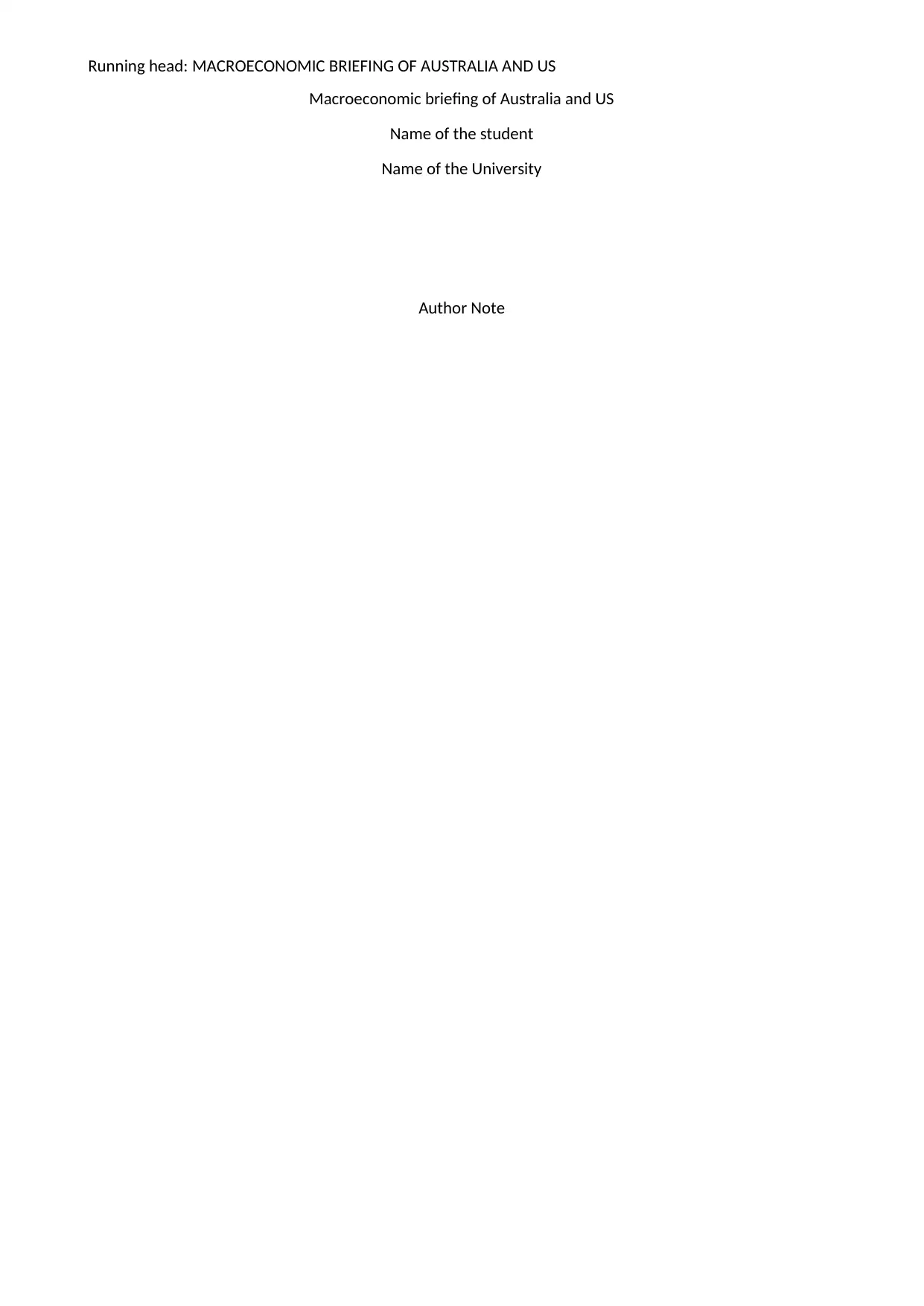
Running head: MACROECONOMIC BRIEFING OF AUSTRALIA AND US
Macroeconomic briefing of Australia and US
Name of the student
Name of the University
Author Note
Macroeconomic briefing of Australia and US
Name of the student
Name of the University
Author Note
Secure Best Marks with AI Grader
Need help grading? Try our AI Grader for instant feedback on your assignments.
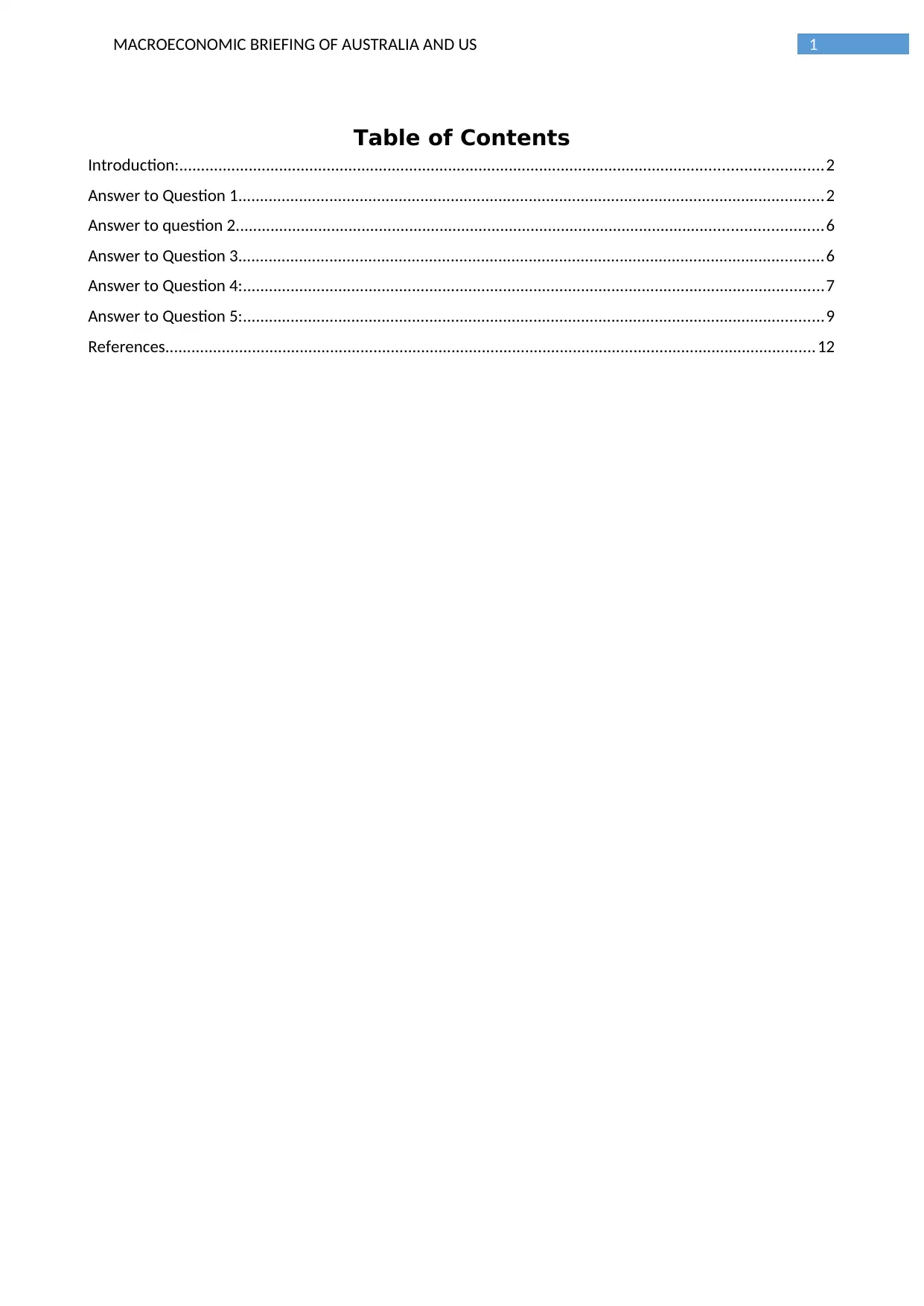
1MACROECONOMIC BRIEFING OF AUSTRALIA AND US
Table of Contents
Introduction:....................................................................................................................................................2
Answer to Question 1.......................................................................................................................................2
Answer to question 2.......................................................................................................................................6
Answer to Question 3.......................................................................................................................................6
Answer to Question 4:......................................................................................................................................7
Answer to Question 5:......................................................................................................................................9
References......................................................................................................................................................12
Table of Contents
Introduction:....................................................................................................................................................2
Answer to Question 1.......................................................................................................................................2
Answer to question 2.......................................................................................................................................6
Answer to Question 3.......................................................................................................................................6
Answer to Question 4:......................................................................................................................................7
Answer to Question 5:......................................................................................................................................9
References......................................................................................................................................................12

2MACROECONOMIC BRIEFING OF AUSTRALIA AND US
Introduction:
In order to answer the given questions, two counties that are Australia and United States are taken
into consideration. The rate of growth of the gross domestic product, unemployment rate and the inflation
rate of Australia and the United States is collected from the Word Bank database and the International
Monetary Fund database. The data is collected from the databases from a period of 2000 to 2017. The
historical data is considered for the time period of 2000 to 2014 and the current data is considered for the
period of 2015 to 2017.
Answer to Question 1
The growth rate in gross domestic product is calculated annually at market price based on the local
currency. The aggregated are based on constant 2010 United States dollars. The rate of growth of the gross
domestic product for Australia in the period of 2000 was 3.94 percent annually. The highest rate of growth
of the gross domestic product was achieved by the Australian economy during the period of 2002 and 2004
which was around 4 percent. The economy was performing well during the period of 2007 and 2008 with a
growth of 3.77 and 3.65 per annum.In the year 2009 the suffered a set back and the rate of growth of the
economy fell to 1.92 percent. In the year 2012 the growth was around 3.89 percent ("World Bank Open
Data | Data", 2018).The graphical analysis is provided below.
2000 2001 2002 2003 2004 2005 2006 2007 2008 2009 2010 2011 2012 2013 2014 2015 2016 2017
0
0.5
1
1.5
2
2.5
3
3.5
4
4.5
GDP growth of Australia
GDP growth of Australia
Figure 1: GDP of Australia
Source: Author’s own creation in MS Excel
Now, for United States, the growth rate of gross domestic product was 4 percent during the period
of 2000. It fell significantly to 0.97 percent in the year 2001. The economy started recovering from this low
growth level and increased to 3.34 percent per annum in 2005. During the period of 2008 and 2009 the US
Introduction:
In order to answer the given questions, two counties that are Australia and United States are taken
into consideration. The rate of growth of the gross domestic product, unemployment rate and the inflation
rate of Australia and the United States is collected from the Word Bank database and the International
Monetary Fund database. The data is collected from the databases from a period of 2000 to 2017. The
historical data is considered for the time period of 2000 to 2014 and the current data is considered for the
period of 2015 to 2017.
Answer to Question 1
The growth rate in gross domestic product is calculated annually at market price based on the local
currency. The aggregated are based on constant 2010 United States dollars. The rate of growth of the gross
domestic product for Australia in the period of 2000 was 3.94 percent annually. The highest rate of growth
of the gross domestic product was achieved by the Australian economy during the period of 2002 and 2004
which was around 4 percent. The economy was performing well during the period of 2007 and 2008 with a
growth of 3.77 and 3.65 per annum.In the year 2009 the suffered a set back and the rate of growth of the
economy fell to 1.92 percent. In the year 2012 the growth was around 3.89 percent ("World Bank Open
Data | Data", 2018).The graphical analysis is provided below.
2000 2001 2002 2003 2004 2005 2006 2007 2008 2009 2010 2011 2012 2013 2014 2015 2016 2017
0
0.5
1
1.5
2
2.5
3
3.5
4
4.5
GDP growth of Australia
GDP growth of Australia
Figure 1: GDP of Australia
Source: Author’s own creation in MS Excel
Now, for United States, the growth rate of gross domestic product was 4 percent during the period
of 2000. It fell significantly to 0.97 percent in the year 2001. The economy started recovering from this low
growth level and increased to 3.34 percent per annum in 2005. During the period of 2008 and 2009 the US
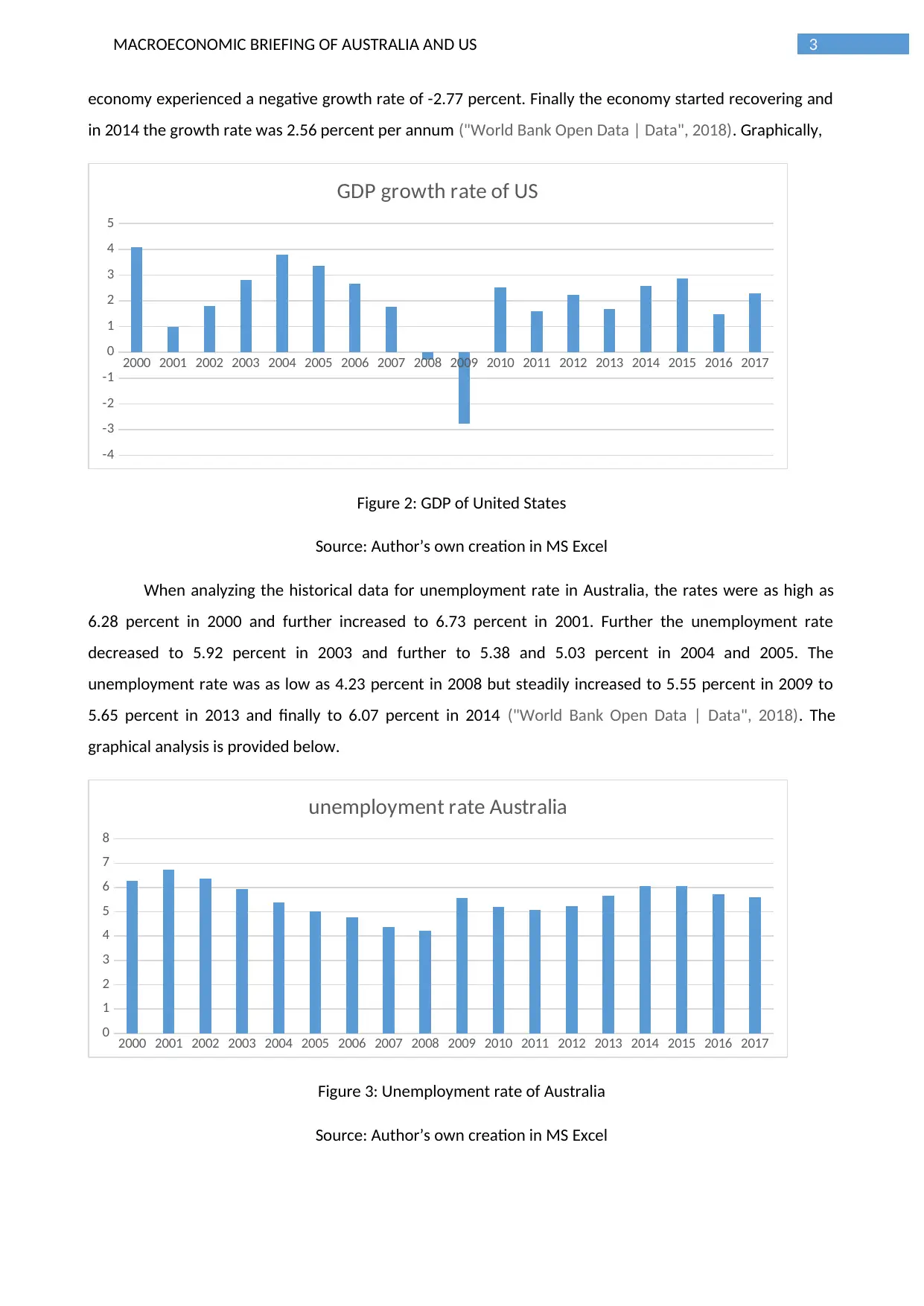
3MACROECONOMIC BRIEFING OF AUSTRALIA AND US
economy experienced a negative growth rate of -2.77 percent. Finally the economy started recovering and
in 2014 the growth rate was 2.56 percent per annum ("World Bank Open Data | Data", 2018). Graphically,
2000 2001 2002 2003 2004 2005 2006 2007 2008 2009 2010 2011 2012 2013 2014 2015 2016 2017
-4
-3
-2
-1
0
1
2
3
4
5
GDP growth rate of US
Figure 2: GDP of United States
Source: Author’s own creation in MS Excel
When analyzing the historical data for unemployment rate in Australia, the rates were as high as
6.28 percent in 2000 and further increased to 6.73 percent in 2001. Further the unemployment rate
decreased to 5.92 percent in 2003 and further to 5.38 and 5.03 percent in 2004 and 2005. The
unemployment rate was as low as 4.23 percent in 2008 but steadily increased to 5.55 percent in 2009 to
5.65 percent in 2013 and finally to 6.07 percent in 2014 ("World Bank Open Data | Data", 2018). The
graphical analysis is provided below.
2000 2001 2002 2003 2004 2005 2006 2007 2008 2009 2010 2011 2012 2013 2014 2015 2016 2017
0
1
2
3
4
5
6
7
8
unemployment rate Australia
Figure 3: Unemployment rate of Australia
Source: Author’s own creation in MS Excel
economy experienced a negative growth rate of -2.77 percent. Finally the economy started recovering and
in 2014 the growth rate was 2.56 percent per annum ("World Bank Open Data | Data", 2018). Graphically,
2000 2001 2002 2003 2004 2005 2006 2007 2008 2009 2010 2011 2012 2013 2014 2015 2016 2017
-4
-3
-2
-1
0
1
2
3
4
5
GDP growth rate of US
Figure 2: GDP of United States
Source: Author’s own creation in MS Excel
When analyzing the historical data for unemployment rate in Australia, the rates were as high as
6.28 percent in 2000 and further increased to 6.73 percent in 2001. Further the unemployment rate
decreased to 5.92 percent in 2003 and further to 5.38 and 5.03 percent in 2004 and 2005. The
unemployment rate was as low as 4.23 percent in 2008 but steadily increased to 5.55 percent in 2009 to
5.65 percent in 2013 and finally to 6.07 percent in 2014 ("World Bank Open Data | Data", 2018). The
graphical analysis is provided below.
2000 2001 2002 2003 2004 2005 2006 2007 2008 2009 2010 2011 2012 2013 2014 2015 2016 2017
0
1
2
3
4
5
6
7
8
unemployment rate Australia
Figure 3: Unemployment rate of Australia
Source: Author’s own creation in MS Excel
Secure Best Marks with AI Grader
Need help grading? Try our AI Grader for instant feedback on your assignments.

4MACROECONOMIC BRIEFING OF AUSTRALIA AND US
The unemployment rate for US was around 3.99 percent for the year 2000. The rate increased
slowly from 4073 percent in 2001 to 5.98 on 2003 and further to 5.78 in the year 2008. However in the
years of 2009 and 2010 the unemployment rate was as high as 9.25 and 9.63 percent respectively. This high
rate started falling to 8.94 to 8.06 from 2011 to 2012. Finally in the year 2014 the rate was as low as 6.17
percent ("World Bank Open Data | Data", 2018). Diagrammatically, the results are shown as follows.
2000 2001 2002 2003 2004 2005 2006 2007 2008 2009 2010 2011 2012 2013 2014 2015 2016 2017
0
2
4
6
8
10
12
Unemployment rate US
Figure 4: Unemployment rate of Australia
Source: Author’s own creation in MS Excel
The inflation rate is calculated using the consumer price index data. The historical inflation rates for
Australia is about 405 percent in the year 2000 that gradually decreased to 3 percent in the year 2002 and
further to 2.3 percent in the year of 2004. The rate of inflation increased to 4.3 percent in the year 2008
and surprisingly to 1.8 percent in 2009 further increasing to 3.3 percent in 20111 and finally to 2.5 percent
in the year 2014. Diagrammatically,
2000 2001 2002 2003 2004 2005 2006 2007 2008 2009 2010 2011 2012 2013 2014 2015 2016 2017
0
0.5
1
1.5
2
2.5
3
3.5
4
4.5
5
inflation rate of Australia
Figure 5: inflation rate of Australia
Source: Author’s own creation in MS Excel
The unemployment rate for US was around 3.99 percent for the year 2000. The rate increased
slowly from 4073 percent in 2001 to 5.98 on 2003 and further to 5.78 in the year 2008. However in the
years of 2009 and 2010 the unemployment rate was as high as 9.25 and 9.63 percent respectively. This high
rate started falling to 8.94 to 8.06 from 2011 to 2012. Finally in the year 2014 the rate was as low as 6.17
percent ("World Bank Open Data | Data", 2018). Diagrammatically, the results are shown as follows.
2000 2001 2002 2003 2004 2005 2006 2007 2008 2009 2010 2011 2012 2013 2014 2015 2016 2017
0
2
4
6
8
10
12
Unemployment rate US
Figure 4: Unemployment rate of Australia
Source: Author’s own creation in MS Excel
The inflation rate is calculated using the consumer price index data. The historical inflation rates for
Australia is about 405 percent in the year 2000 that gradually decreased to 3 percent in the year 2002 and
further to 2.3 percent in the year of 2004. The rate of inflation increased to 4.3 percent in the year 2008
and surprisingly to 1.8 percent in 2009 further increasing to 3.3 percent in 20111 and finally to 2.5 percent
in the year 2014. Diagrammatically,
2000 2001 2002 2003 2004 2005 2006 2007 2008 2009 2010 2011 2012 2013 2014 2015 2016 2017
0
0.5
1
1.5
2
2.5
3
3.5
4
4.5
5
inflation rate of Australia
Figure 5: inflation rate of Australia
Source: Author’s own creation in MS Excel

5MACROECONOMIC BRIEFING OF AUSTRALIA AND US
Now, considering the inflation rates for United States it can be seen that the inflation rate was
around 3.4 percent in the year of 2000. The rates declined steadily to 1.6 percent in the year 2002.
However, there was further increase in the rate of inflation. The rate increased steadily to around 3.4
[percent in the year 2005. In the year 2008 this rate was 3.8 percent and during the period of 2009 there
was a negative rate of inflation. After this, inflation rate increased to 3.1 percent in 2011 and 1.6 percent in
2014.
2000 2001 2002 2003 2004 2005 2006 2007 2008 2009 2010 2011 2012 2013 2014 2015 2016 2017
-1
0
1
2
3
4
5
inflation rate of US
Figure 6: inflation rate of United States
Source: Author’s own creation in MS Excel
From the above historical data it can be analyzed that the Australian economy from the period of
2000 to 2008 was performing well. The economy was in the phase of expansion with high economic
growths and low level of unemployment and inflation rates. However, in the years of 2009 there was an
economic depression that was observed in the Australian economy which led to contraction of the
economy and eventually to trough. The economy eventually started to recover after 2009 and there was
expansion of the economy till 2014.
The economy of the United States was performing well in the early phase of the 19 th century. The
economy reached to the peak in the year of 2004. However, there was a severe depression during the
period of 2008 and 2009. The economy came to a trough. There was high level of unemployment and fall in
the rate of inflation in the United States economy. The economy came to a trough. However, in the
consequent years the economy started to recover. There was increase in the growth of the gross domestic
product, the rate of unemployment also decreased significantly till the year 2014. Thus the economy
started to recover from the recession of 2009.
Now, considering the inflation rates for United States it can be seen that the inflation rate was
around 3.4 percent in the year of 2000. The rates declined steadily to 1.6 percent in the year 2002.
However, there was further increase in the rate of inflation. The rate increased steadily to around 3.4
[percent in the year 2005. In the year 2008 this rate was 3.8 percent and during the period of 2009 there
was a negative rate of inflation. After this, inflation rate increased to 3.1 percent in 2011 and 1.6 percent in
2014.
2000 2001 2002 2003 2004 2005 2006 2007 2008 2009 2010 2011 2012 2013 2014 2015 2016 2017
-1
0
1
2
3
4
5
inflation rate of US
Figure 6: inflation rate of United States
Source: Author’s own creation in MS Excel
From the above historical data it can be analyzed that the Australian economy from the period of
2000 to 2008 was performing well. The economy was in the phase of expansion with high economic
growths and low level of unemployment and inflation rates. However, in the years of 2009 there was an
economic depression that was observed in the Australian economy which led to contraction of the
economy and eventually to trough. The economy eventually started to recover after 2009 and there was
expansion of the economy till 2014.
The economy of the United States was performing well in the early phase of the 19 th century. The
economy reached to the peak in the year of 2004. However, there was a severe depression during the
period of 2008 and 2009. The economy came to a trough. There was high level of unemployment and fall in
the rate of inflation in the United States economy. The economy came to a trough. However, in the
consequent years the economy started to recover. There was increase in the growth of the gross domestic
product, the rate of unemployment also decreased significantly till the year 2014. Thus the economy
started to recover from the recession of 2009.
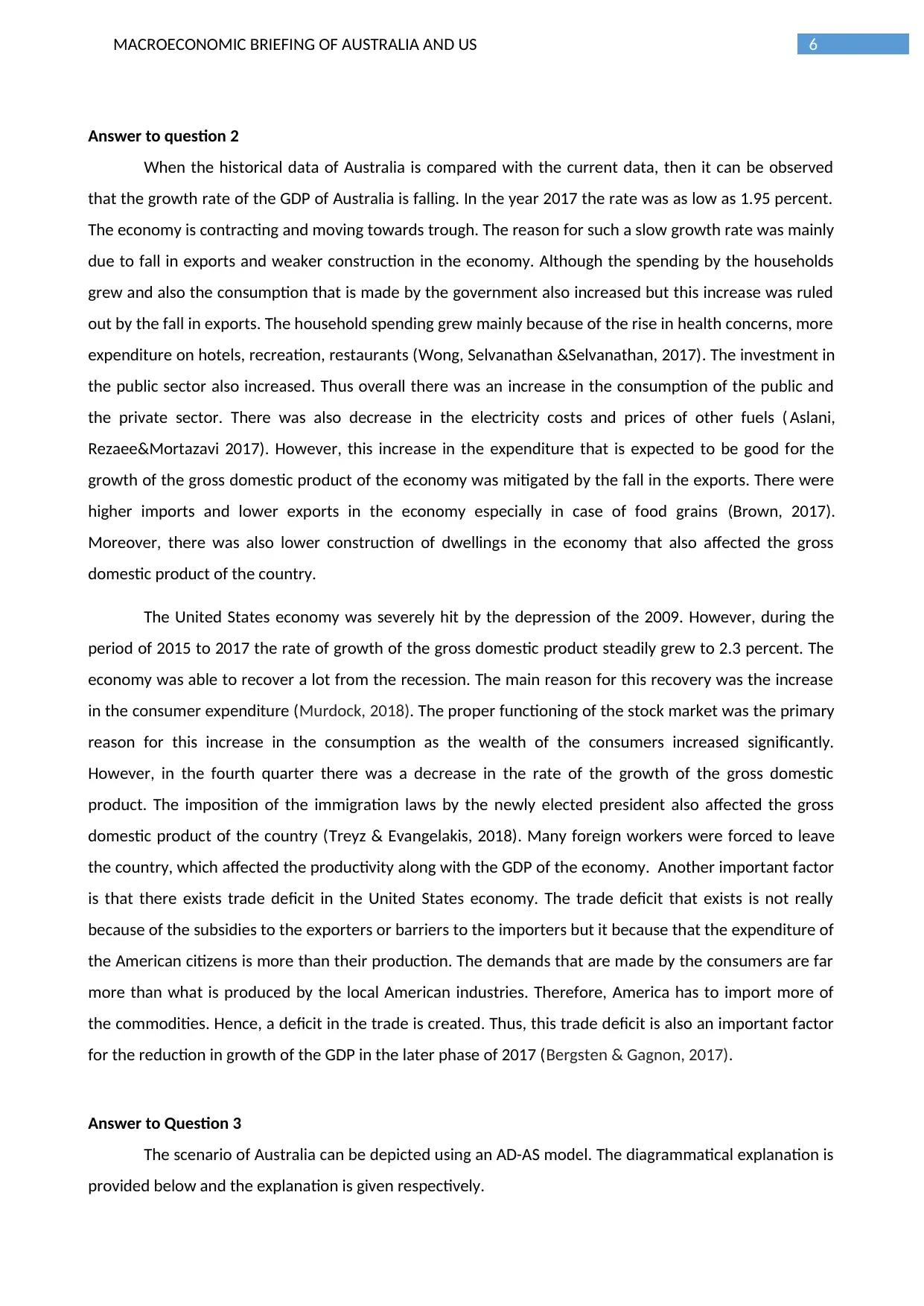
6MACROECONOMIC BRIEFING OF AUSTRALIA AND US
Answer to question 2
When the historical data of Australia is compared with the current data, then it can be observed
that the growth rate of the GDP of Australia is falling. In the year 2017 the rate was as low as 1.95 percent.
The economy is contracting and moving towards trough. The reason for such a slow growth rate was mainly
due to fall in exports and weaker construction in the economy. Although the spending by the households
grew and also the consumption that is made by the government also increased but this increase was ruled
out by the fall in exports. The household spending grew mainly because of the rise in health concerns, more
expenditure on hotels, recreation, restaurants (Wong, Selvanathan &Selvanathan, 2017). The investment in
the public sector also increased. Thus overall there was an increase in the consumption of the public and
the private sector. There was also decrease in the electricity costs and prices of other fuels ( Aslani,
Rezaee&Mortazavi 2017). However, this increase in the expenditure that is expected to be good for the
growth of the gross domestic product of the economy was mitigated by the fall in the exports. There were
higher imports and lower exports in the economy especially in case of food grains (Brown, 2017).
Moreover, there was also lower construction of dwellings in the economy that also affected the gross
domestic product of the country.
The United States economy was severely hit by the depression of the 2009. However, during the
period of 2015 to 2017 the rate of growth of the gross domestic product steadily grew to 2.3 percent. The
economy was able to recover a lot from the recession. The main reason for this recovery was the increase
in the consumer expenditure (Murdock, 2018). The proper functioning of the stock market was the primary
reason for this increase in the consumption as the wealth of the consumers increased significantly.
However, in the fourth quarter there was a decrease in the rate of the growth of the gross domestic
product. The imposition of the immigration laws by the newly elected president also affected the gross
domestic product of the country (Treyz & Evangelakis, 2018). Many foreign workers were forced to leave
the country, which affected the productivity along with the GDP of the economy. Another important factor
is that there exists trade deficit in the United States economy. The trade deficit that exists is not really
because of the subsidies to the exporters or barriers to the importers but it because that the expenditure of
the American citizens is more than their production. The demands that are made by the consumers are far
more than what is produced by the local American industries. Therefore, America has to import more of
the commodities. Hence, a deficit in the trade is created. Thus, this trade deficit is also an important factor
for the reduction in growth of the GDP in the later phase of 2017 (Bergsten & Gagnon, 2017).
Answer to Question 3
The scenario of Australia can be depicted using an AD-AS model. The diagrammatical explanation is
provided below and the explanation is given respectively.
Answer to question 2
When the historical data of Australia is compared with the current data, then it can be observed
that the growth rate of the GDP of Australia is falling. In the year 2017 the rate was as low as 1.95 percent.
The economy is contracting and moving towards trough. The reason for such a slow growth rate was mainly
due to fall in exports and weaker construction in the economy. Although the spending by the households
grew and also the consumption that is made by the government also increased but this increase was ruled
out by the fall in exports. The household spending grew mainly because of the rise in health concerns, more
expenditure on hotels, recreation, restaurants (Wong, Selvanathan &Selvanathan, 2017). The investment in
the public sector also increased. Thus overall there was an increase in the consumption of the public and
the private sector. There was also decrease in the electricity costs and prices of other fuels ( Aslani,
Rezaee&Mortazavi 2017). However, this increase in the expenditure that is expected to be good for the
growth of the gross domestic product of the economy was mitigated by the fall in the exports. There were
higher imports and lower exports in the economy especially in case of food grains (Brown, 2017).
Moreover, there was also lower construction of dwellings in the economy that also affected the gross
domestic product of the country.
The United States economy was severely hit by the depression of the 2009. However, during the
period of 2015 to 2017 the rate of growth of the gross domestic product steadily grew to 2.3 percent. The
economy was able to recover a lot from the recession. The main reason for this recovery was the increase
in the consumer expenditure (Murdock, 2018). The proper functioning of the stock market was the primary
reason for this increase in the consumption as the wealth of the consumers increased significantly.
However, in the fourth quarter there was a decrease in the rate of the growth of the gross domestic
product. The imposition of the immigration laws by the newly elected president also affected the gross
domestic product of the country (Treyz & Evangelakis, 2018). Many foreign workers were forced to leave
the country, which affected the productivity along with the GDP of the economy. Another important factor
is that there exists trade deficit in the United States economy. The trade deficit that exists is not really
because of the subsidies to the exporters or barriers to the importers but it because that the expenditure of
the American citizens is more than their production. The demands that are made by the consumers are far
more than what is produced by the local American industries. Therefore, America has to import more of
the commodities. Hence, a deficit in the trade is created. Thus, this trade deficit is also an important factor
for the reduction in growth of the GDP in the later phase of 2017 (Bergsten & Gagnon, 2017).
Answer to Question 3
The scenario of Australia can be depicted using an AD-AS model. The diagrammatical explanation is
provided below and the explanation is given respectively.
Paraphrase This Document
Need a fresh take? Get an instant paraphrase of this document with our AI Paraphraser
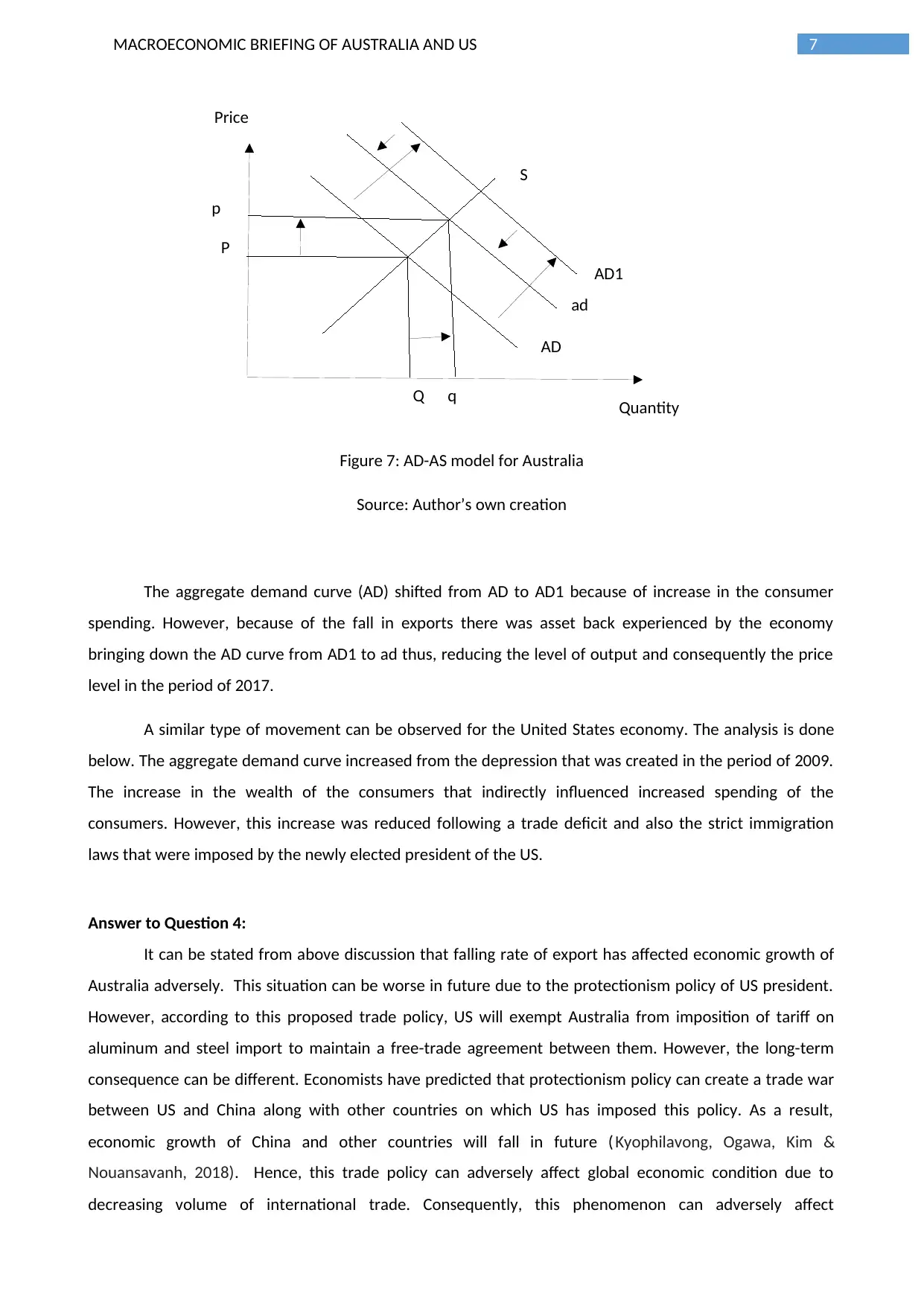
S
AD
ad
Quantity
Price
p
P
Q q
AD1
7MACROECONOMIC BRIEFING OF AUSTRALIA AND US
Figure 7: AD-AS model for Australia
Source: Author’s own creation
The aggregate demand curve (AD) shifted from AD to AD1 because of increase in the consumer
spending. However, because of the fall in exports there was asset back experienced by the economy
bringing down the AD curve from AD1 to ad thus, reducing the level of output and consequently the price
level in the period of 2017.
A similar type of movement can be observed for the United States economy. The analysis is done
below. The aggregate demand curve increased from the depression that was created in the period of 2009.
The increase in the wealth of the consumers that indirectly influenced increased spending of the
consumers. However, this increase was reduced following a trade deficit and also the strict immigration
laws that were imposed by the newly elected president of the US.
Answer to Question 4:
It can be stated from above discussion that falling rate of export has affected economic growth of
Australia adversely. This situation can be worse in future due to the protectionism policy of US president.
However, according to this proposed trade policy, US will exempt Australia from imposition of tariff on
aluminum and steel import to maintain a free-trade agreement between them. However, the long-term
consequence can be different. Economists have predicted that protectionism policy can create a trade war
between US and China along with other countries on which US has imposed this policy. As a result,
economic growth of China and other countries will fall in future ( Kyophilavong, Ogawa, Kim &
Nouansavanh, 2018). Hence, this trade policy can adversely affect global economic condition due to
decreasing volume of international trade. Consequently, this phenomenon can adversely affect
AD
ad
Quantity
Price
p
P
Q q
AD1
7MACROECONOMIC BRIEFING OF AUSTRALIA AND US
Figure 7: AD-AS model for Australia
Source: Author’s own creation
The aggregate demand curve (AD) shifted from AD to AD1 because of increase in the consumer
spending. However, because of the fall in exports there was asset back experienced by the economy
bringing down the AD curve from AD1 to ad thus, reducing the level of output and consequently the price
level in the period of 2017.
A similar type of movement can be observed for the United States economy. The analysis is done
below. The aggregate demand curve increased from the depression that was created in the period of 2009.
The increase in the wealth of the consumers that indirectly influenced increased spending of the
consumers. However, this increase was reduced following a trade deficit and also the strict immigration
laws that were imposed by the newly elected president of the US.
Answer to Question 4:
It can be stated from above discussion that falling rate of export has affected economic growth of
Australia adversely. This situation can be worse in future due to the protectionism policy of US president.
However, according to this proposed trade policy, US will exempt Australia from imposition of tariff on
aluminum and steel import to maintain a free-trade agreement between them. However, the long-term
consequence can be different. Economists have predicted that protectionism policy can create a trade war
between US and China along with other countries on which US has imposed this policy. As a result,
economic growth of China and other countries will fall in future ( Kyophilavong, Ogawa, Kim &
Nouansavanh, 2018). Hence, this trade policy can adversely affect global economic condition due to
decreasing volume of international trade. Consequently, this phenomenon can adversely affect
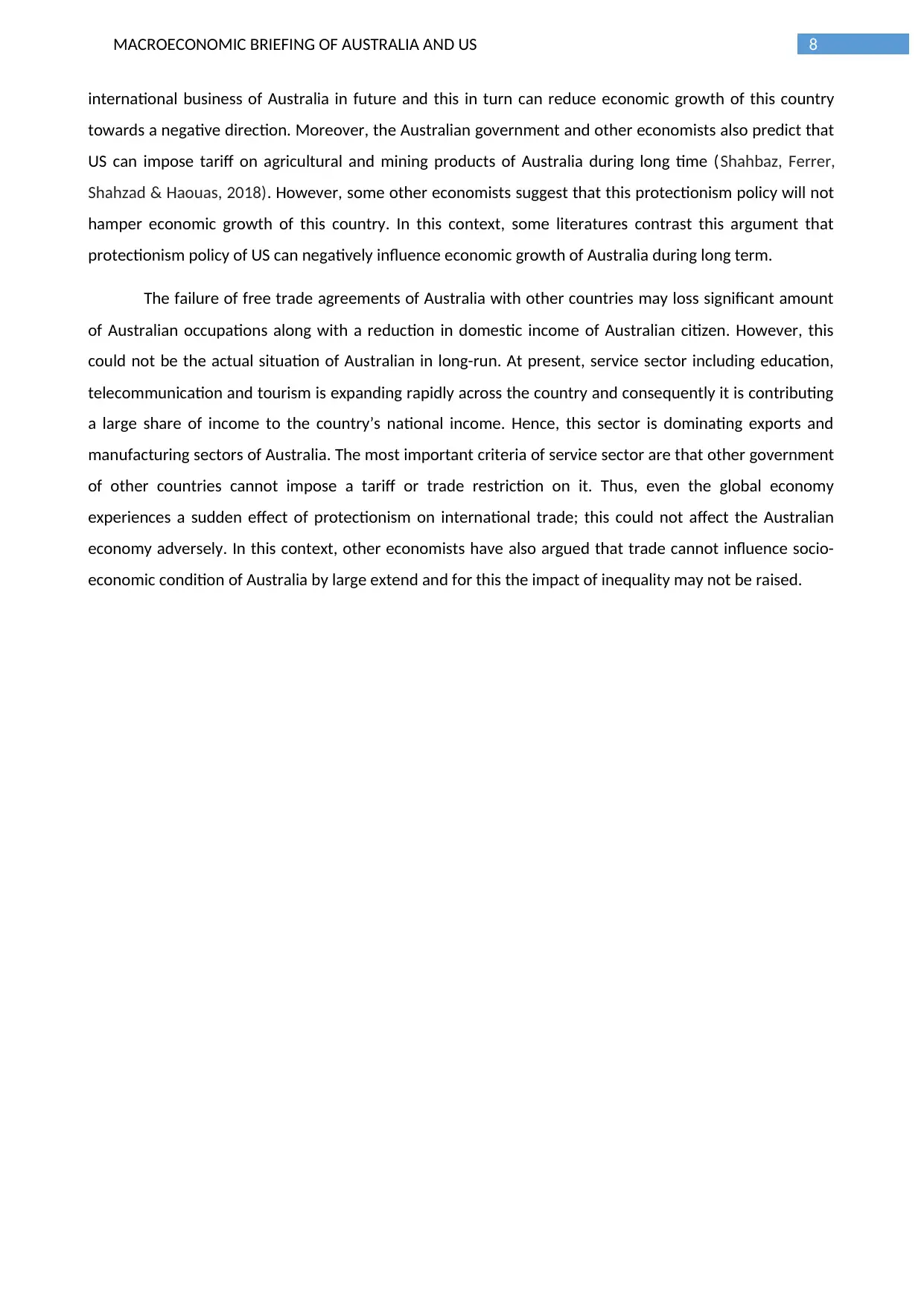
8MACROECONOMIC BRIEFING OF AUSTRALIA AND US
international business of Australia in future and this in turn can reduce economic growth of this country
towards a negative direction. Moreover, the Australian government and other economists also predict that
US can impose tariff on agricultural and mining products of Australia during long time (Shahbaz, Ferrer,
Shahzad & Haouas, 2018). However, some other economists suggest that this protectionism policy will not
hamper economic growth of this country. In this context, some literatures contrast this argument that
protectionism policy of US can negatively influence economic growth of Australia during long term.
The failure of free trade agreements of Australia with other countries may loss significant amount
of Australian occupations along with a reduction in domestic income of Australian citizen. However, this
could not be the actual situation of Australian in long-run. At present, service sector including education,
telecommunication and tourism is expanding rapidly across the country and consequently it is contributing
a large share of income to the country’s national income. Hence, this sector is dominating exports and
manufacturing sectors of Australia. The most important criteria of service sector are that other government
of other countries cannot impose a tariff or trade restriction on it. Thus, even the global economy
experiences a sudden effect of protectionism on international trade; this could not affect the Australian
economy adversely. In this context, other economists have also argued that trade cannot influence socio-
economic condition of Australia by large extend and for this the impact of inequality may not be raised.
international business of Australia in future and this in turn can reduce economic growth of this country
towards a negative direction. Moreover, the Australian government and other economists also predict that
US can impose tariff on agricultural and mining products of Australia during long time (Shahbaz, Ferrer,
Shahzad & Haouas, 2018). However, some other economists suggest that this protectionism policy will not
hamper economic growth of this country. In this context, some literatures contrast this argument that
protectionism policy of US can negatively influence economic growth of Australia during long term.
The failure of free trade agreements of Australia with other countries may loss significant amount
of Australian occupations along with a reduction in domestic income of Australian citizen. However, this
could not be the actual situation of Australian in long-run. At present, service sector including education,
telecommunication and tourism is expanding rapidly across the country and consequently it is contributing
a large share of income to the country’s national income. Hence, this sector is dominating exports and
manufacturing sectors of Australia. The most important criteria of service sector are that other government
of other countries cannot impose a tariff or trade restriction on it. Thus, even the global economy
experiences a sudden effect of protectionism on international trade; this could not affect the Australian
economy adversely. In this context, other economists have also argued that trade cannot influence socio-
economic condition of Australia by large extend and for this the impact of inequality may not be raised.
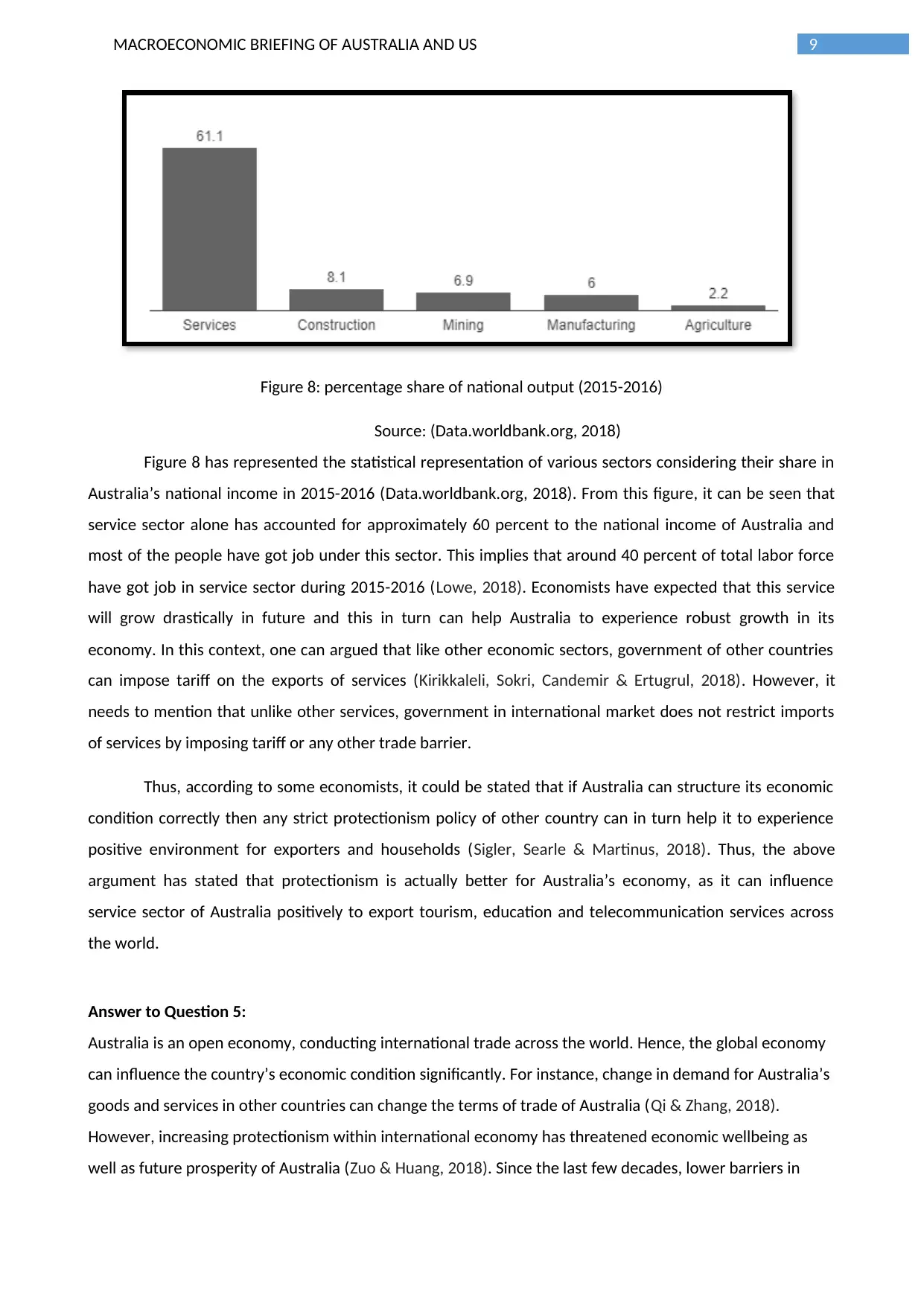
9MACROECONOMIC BRIEFING OF AUSTRALIA AND US
Figure 8: percentage share of national output (2015-2016)
Source: (Data.worldbank.org, 2018)
Figure 8 has represented the statistical representation of various sectors considering their share in
Australia’s national income in 2015-2016 (Data.worldbank.org, 2018). From this figure, it can be seen that
service sector alone has accounted for approximately 60 percent to the national income of Australia and
most of the people have got job under this sector. This implies that around 40 percent of total labor force
have got job in service sector during 2015-2016 (Lowe, 2018). Economists have expected that this service
will grow drastically in future and this in turn can help Australia to experience robust growth in its
economy. In this context, one can argued that like other economic sectors, government of other countries
can impose tariff on the exports of services (Kirikkaleli, Sokri, Candemir & Ertugrul, 2018). However, it
needs to mention that unlike other services, government in international market does not restrict imports
of services by imposing tariff or any other trade barrier.
Thus, according to some economists, it could be stated that if Australia can structure its economic
condition correctly then any strict protectionism policy of other country can in turn help it to experience
positive environment for exporters and households (Sigler, Searle & Martinus, 2018). Thus, the above
argument has stated that protectionism is actually better for Australia’s economy, as it can influence
service sector of Australia positively to export tourism, education and telecommunication services across
the world.
Answer to Question 5:
Australia is an open economy, conducting international trade across the world. Hence, the global economy
can influence the country’s economic condition significantly. For instance, change in demand for Australia’s
goods and services in other countries can change the terms of trade of Australia (Qi & Zhang, 2018).
However, increasing protectionism within international economy has threatened economic wellbeing as
well as future prosperity of Australia (Zuo & Huang, 2018). Since the last few decades, lower barriers in
Figure 8: percentage share of national output (2015-2016)
Source: (Data.worldbank.org, 2018)
Figure 8 has represented the statistical representation of various sectors considering their share in
Australia’s national income in 2015-2016 (Data.worldbank.org, 2018). From this figure, it can be seen that
service sector alone has accounted for approximately 60 percent to the national income of Australia and
most of the people have got job under this sector. This implies that around 40 percent of total labor force
have got job in service sector during 2015-2016 (Lowe, 2018). Economists have expected that this service
will grow drastically in future and this in turn can help Australia to experience robust growth in its
economy. In this context, one can argued that like other economic sectors, government of other countries
can impose tariff on the exports of services (Kirikkaleli, Sokri, Candemir & Ertugrul, 2018). However, it
needs to mention that unlike other services, government in international market does not restrict imports
of services by imposing tariff or any other trade barrier.
Thus, according to some economists, it could be stated that if Australia can structure its economic
condition correctly then any strict protectionism policy of other country can in turn help it to experience
positive environment for exporters and households (Sigler, Searle & Martinus, 2018). Thus, the above
argument has stated that protectionism is actually better for Australia’s economy, as it can influence
service sector of Australia positively to export tourism, education and telecommunication services across
the world.
Answer to Question 5:
Australia is an open economy, conducting international trade across the world. Hence, the global economy
can influence the country’s economic condition significantly. For instance, change in demand for Australia’s
goods and services in other countries can change the terms of trade of Australia (Qi & Zhang, 2018).
However, increasing protectionism within international economy has threatened economic wellbeing as
well as future prosperity of Australia (Zuo & Huang, 2018). Since the last few decades, lower barriers in
Secure Best Marks with AI Grader
Need help grading? Try our AI Grader for instant feedback on your assignments.
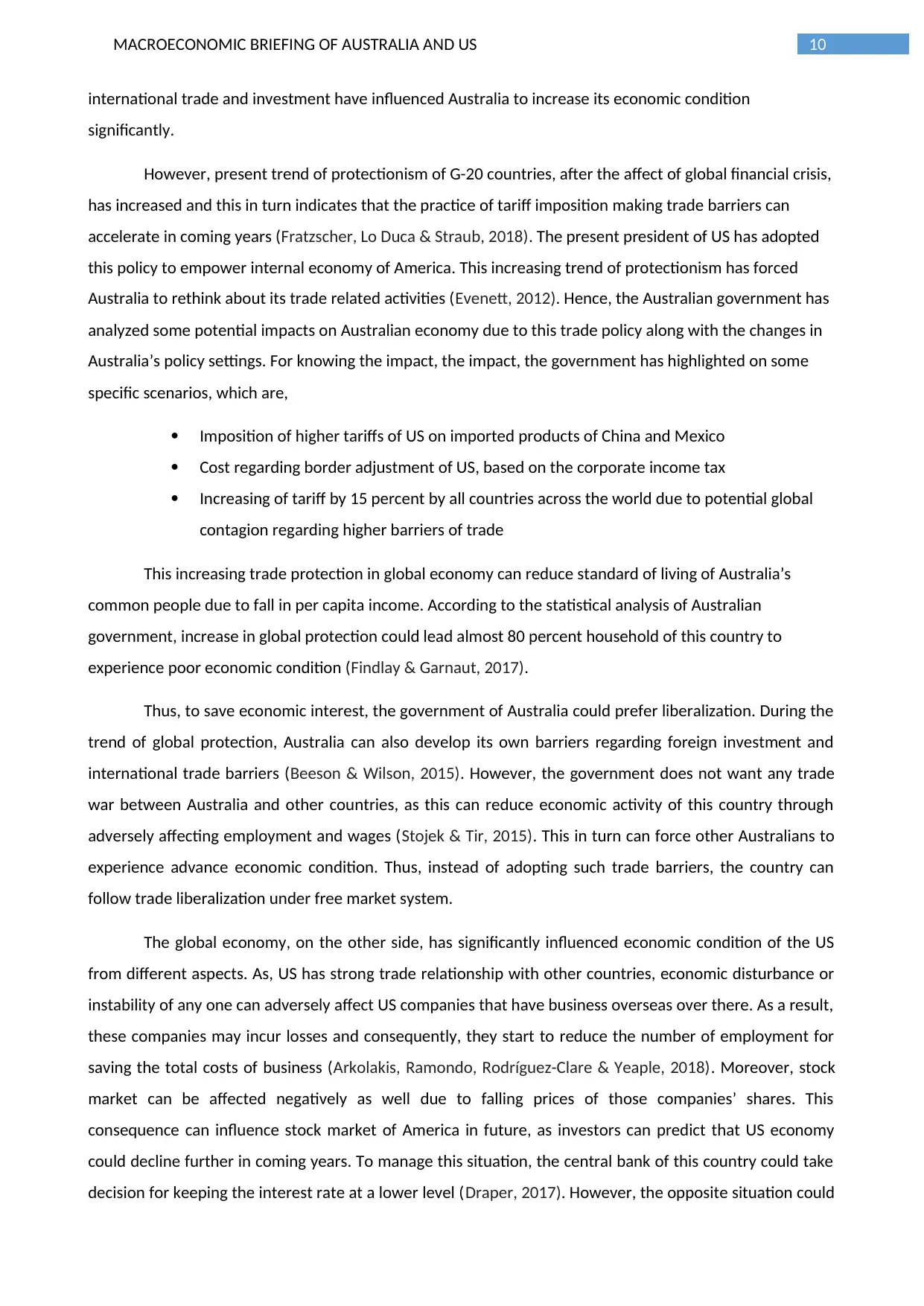
10MACROECONOMIC BRIEFING OF AUSTRALIA AND US
international trade and investment have influenced Australia to increase its economic condition
significantly.
However, present trend of protectionism of G-20 countries, after the affect of global financial crisis,
has increased and this in turn indicates that the practice of tariff imposition making trade barriers can
accelerate in coming years (Fratzscher, Lo Duca & Straub, 2018). The present president of US has adopted
this policy to empower internal economy of America. This increasing trend of protectionism has forced
Australia to rethink about its trade related activities (Evenett, 2012). Hence, the Australian government has
analyzed some potential impacts on Australian economy due to this trade policy along with the changes in
Australia’s policy settings. For knowing the impact, the impact, the government has highlighted on some
specific scenarios, which are,
Imposition of higher tariffs of US on imported products of China and Mexico
Cost regarding border adjustment of US, based on the corporate income tax
Increasing of tariff by 15 percent by all countries across the world due to potential global
contagion regarding higher barriers of trade
This increasing trade protection in global economy can reduce standard of living of Australia’s
common people due to fall in per capita income. According to the statistical analysis of Australian
government, increase in global protection could lead almost 80 percent household of this country to
experience poor economic condition (Findlay & Garnaut, 2017).
Thus, to save economic interest, the government of Australia could prefer liberalization. During the
trend of global protection, Australia can also develop its own barriers regarding foreign investment and
international trade barriers (Beeson & Wilson, 2015). However, the government does not want any trade
war between Australia and other countries, as this can reduce economic activity of this country through
adversely affecting employment and wages (Stojek & Tir, 2015). This in turn can force other Australians to
experience advance economic condition. Thus, instead of adopting such trade barriers, the country can
follow trade liberalization under free market system.
The global economy, on the other side, has significantly influenced economic condition of the US
from different aspects. As, US has strong trade relationship with other countries, economic disturbance or
instability of any one can adversely affect US companies that have business overseas over there. As a result,
these companies may incur losses and consequently, they start to reduce the number of employment for
saving the total costs of business (Arkolakis, Ramondo, Rodríguez-Clare & Yeaple, 2018). Moreover, stock
market can be affected negatively as well due to falling prices of those companies’ shares. This
consequence can influence stock market of America in future, as investors can predict that US economy
could decline further in coming years. To manage this situation, the central bank of this country could take
decision for keeping the interest rate at a lower level (Draper, 2017). However, the opposite situation could
international trade and investment have influenced Australia to increase its economic condition
significantly.
However, present trend of protectionism of G-20 countries, after the affect of global financial crisis,
has increased and this in turn indicates that the practice of tariff imposition making trade barriers can
accelerate in coming years (Fratzscher, Lo Duca & Straub, 2018). The present president of US has adopted
this policy to empower internal economy of America. This increasing trend of protectionism has forced
Australia to rethink about its trade related activities (Evenett, 2012). Hence, the Australian government has
analyzed some potential impacts on Australian economy due to this trade policy along with the changes in
Australia’s policy settings. For knowing the impact, the impact, the government has highlighted on some
specific scenarios, which are,
Imposition of higher tariffs of US on imported products of China and Mexico
Cost regarding border adjustment of US, based on the corporate income tax
Increasing of tariff by 15 percent by all countries across the world due to potential global
contagion regarding higher barriers of trade
This increasing trade protection in global economy can reduce standard of living of Australia’s
common people due to fall in per capita income. According to the statistical analysis of Australian
government, increase in global protection could lead almost 80 percent household of this country to
experience poor economic condition (Findlay & Garnaut, 2017).
Thus, to save economic interest, the government of Australia could prefer liberalization. During the
trend of global protection, Australia can also develop its own barriers regarding foreign investment and
international trade barriers (Beeson & Wilson, 2015). However, the government does not want any trade
war between Australia and other countries, as this can reduce economic activity of this country through
adversely affecting employment and wages (Stojek & Tir, 2015). This in turn can force other Australians to
experience advance economic condition. Thus, instead of adopting such trade barriers, the country can
follow trade liberalization under free market system.
The global economy, on the other side, has significantly influenced economic condition of the US
from different aspects. As, US has strong trade relationship with other countries, economic disturbance or
instability of any one can adversely affect US companies that have business overseas over there. As a result,
these companies may incur losses and consequently, they start to reduce the number of employment for
saving the total costs of business (Arkolakis, Ramondo, Rodríguez-Clare & Yeaple, 2018). Moreover, stock
market can be affected negatively as well due to falling prices of those companies’ shares. This
consequence can influence stock market of America in future, as investors can predict that US economy
could decline further in coming years. To manage this situation, the central bank of this country could take
decision for keeping the interest rate at a lower level (Draper, 2017). However, the opposite situation could
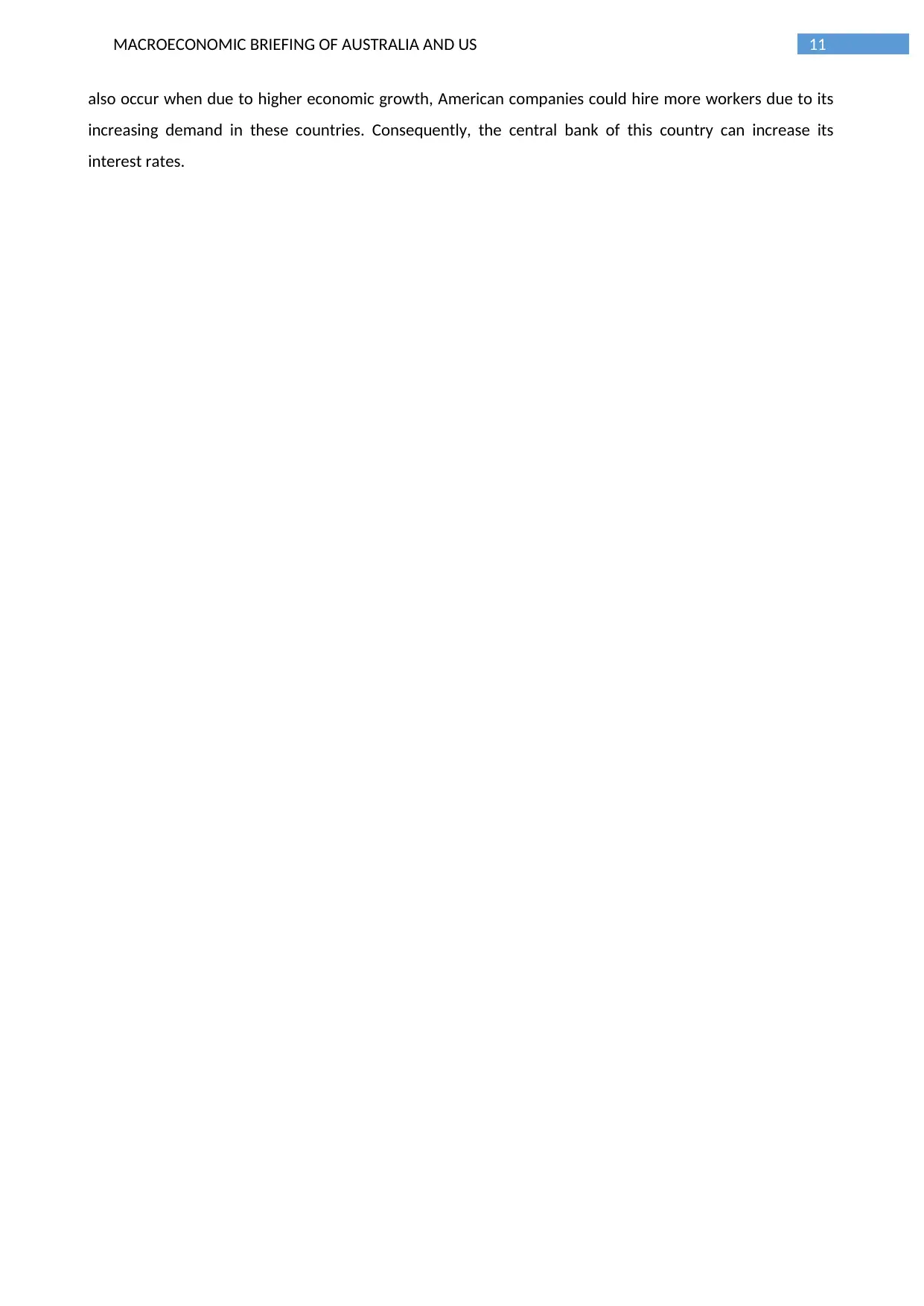
11MACROECONOMIC BRIEFING OF AUSTRALIA AND US
also occur when due to higher economic growth, American companies could hire more workers due to its
increasing demand in these countries. Consequently, the central bank of this country can increase its
interest rates.
also occur when due to higher economic growth, American companies could hire more workers due to its
increasing demand in these countries. Consequently, the central bank of this country can increase its
interest rates.
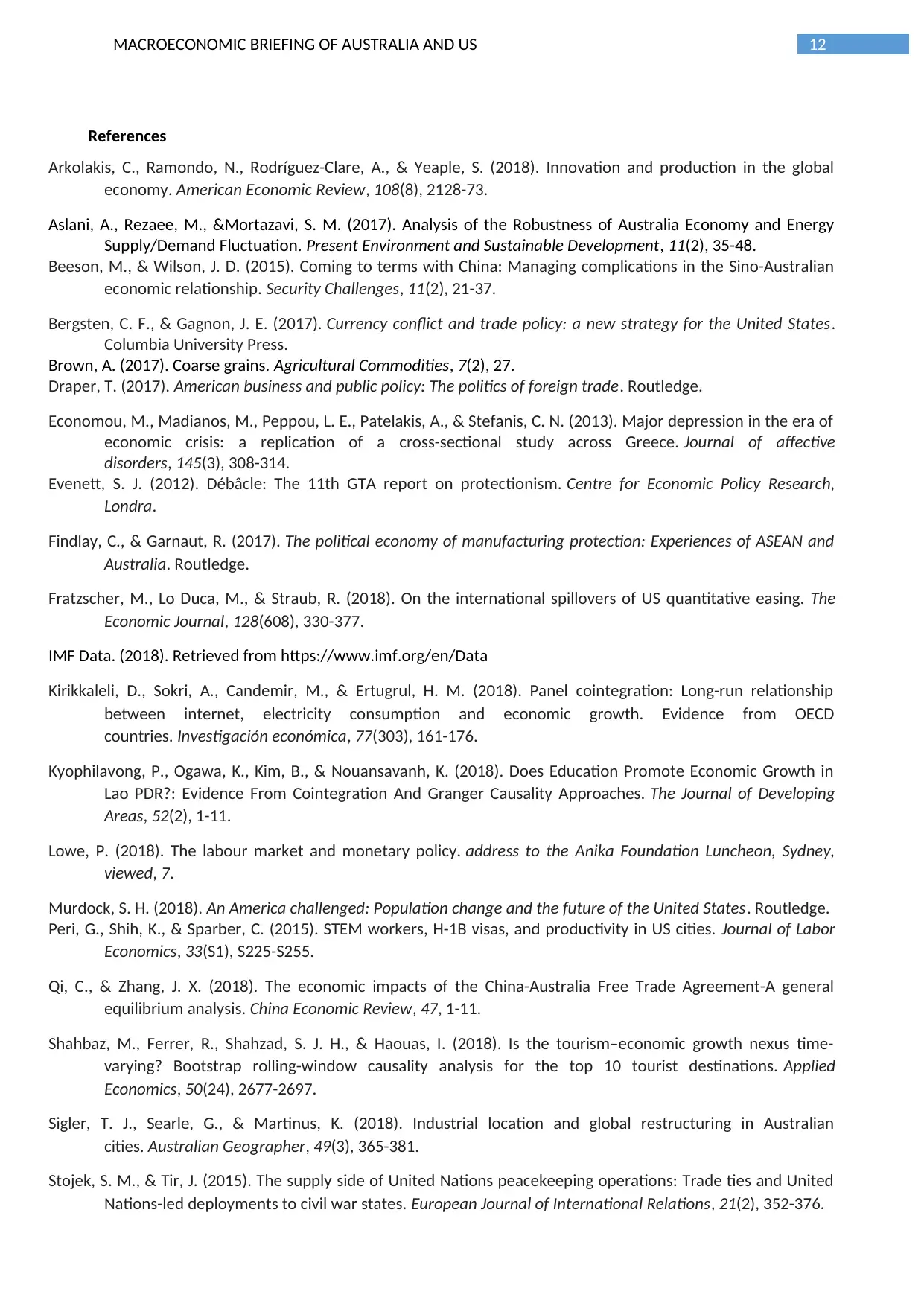
12MACROECONOMIC BRIEFING OF AUSTRALIA AND US
References
Arkolakis, C., Ramondo, N., Rodríguez-Clare, A., & Yeaple, S. (2018). Innovation and production in the global
economy. American Economic Review, 108(8), 2128-73.
Aslani, A., Rezaee, M., &Mortazavi, S. M. (2017). Analysis of the Robustness of Australia Economy and Energy
Supply/Demand Fluctuation. Present Environment and Sustainable Development, 11(2), 35-48.
Beeson, M., & Wilson, J. D. (2015). Coming to terms with China: Managing complications in the Sino-Australian
economic relationship. Security Challenges, 11(2), 21-37.
Bergsten, C. F., & Gagnon, J. E. (2017). Currency conflict and trade policy: a new strategy for the United States.
Columbia University Press.
Brown, A. (2017). Coarse grains. Agricultural Commodities, 7(2), 27.
Draper, T. (2017). American business and public policy: The politics of foreign trade. Routledge.
Economou, M., Madianos, M., Peppou, L. E., Patelakis, A., & Stefanis, C. N. (2013). Major depression in the era of
economic crisis: a replication of a cross-sectional study across Greece. Journal of affective
disorders, 145(3), 308-314.
Evenett, S. J. (2012). Débâcle: The 11th GTA report on protectionism. Centre for Economic Policy Research,
Londra.
Findlay, C., & Garnaut, R. (2017). The political economy of manufacturing protection: Experiences of ASEAN and
Australia. Routledge.
Fratzscher, M., Lo Duca, M., & Straub, R. (2018). On the international spillovers of US quantitative easing. The
Economic Journal, 128(608), 330-377.
IMF Data. (2018). Retrieved from https://www.imf.org/en/Data
Kirikkaleli, D., Sokri, A., Candemir, M., & Ertugrul, H. M. (2018). Panel cointegration: Long-run relationship
between internet, electricity consumption and economic growth. Evidence from OECD
countries. Investigación económica, 77(303), 161-176.
Kyophilavong, P., Ogawa, K., Kim, B., & Nouansavanh, K. (2018). Does Education Promote Economic Growth in
Lao PDR?: Evidence From Cointegration And Granger Causality Approaches. The Journal of Developing
Areas, 52(2), 1-11.
Lowe, P. (2018). The labour market and monetary policy. address to the Anika Foundation Luncheon, Sydney,
viewed, 7.
Murdock, S. H. (2018). An America challenged: Population change and the future of the United States. Routledge.
Peri, G., Shih, K., & Sparber, C. (2015). STEM workers, H-1B visas, and productivity in US cities. Journal of Labor
Economics, 33(S1), S225-S255.
Qi, C., & Zhang, J. X. (2018). The economic impacts of the China-Australia Free Trade Agreement-A general
equilibrium analysis. China Economic Review, 47, 1-11.
Shahbaz, M., Ferrer, R., Shahzad, S. J. H., & Haouas, I. (2018). Is the tourism–economic growth nexus time-
varying? Bootstrap rolling-window causality analysis for the top 10 tourist destinations. Applied
Economics, 50(24), 2677-2697.
Sigler, T. J., Searle, G., & Martinus, K. (2018). Industrial location and global restructuring in Australian
cities. Australian Geographer, 49(3), 365-381.
Stojek, S. M., & Tir, J. (2015). The supply side of United Nations peacekeeping operations: Trade ties and United
Nations-led deployments to civil war states. European Journal of International Relations, 21(2), 352-376.
References
Arkolakis, C., Ramondo, N., Rodríguez-Clare, A., & Yeaple, S. (2018). Innovation and production in the global
economy. American Economic Review, 108(8), 2128-73.
Aslani, A., Rezaee, M., &Mortazavi, S. M. (2017). Analysis of the Robustness of Australia Economy and Energy
Supply/Demand Fluctuation. Present Environment and Sustainable Development, 11(2), 35-48.
Beeson, M., & Wilson, J. D. (2015). Coming to terms with China: Managing complications in the Sino-Australian
economic relationship. Security Challenges, 11(2), 21-37.
Bergsten, C. F., & Gagnon, J. E. (2017). Currency conflict and trade policy: a new strategy for the United States.
Columbia University Press.
Brown, A. (2017). Coarse grains. Agricultural Commodities, 7(2), 27.
Draper, T. (2017). American business and public policy: The politics of foreign trade. Routledge.
Economou, M., Madianos, M., Peppou, L. E., Patelakis, A., & Stefanis, C. N. (2013). Major depression in the era of
economic crisis: a replication of a cross-sectional study across Greece. Journal of affective
disorders, 145(3), 308-314.
Evenett, S. J. (2012). Débâcle: The 11th GTA report on protectionism. Centre for Economic Policy Research,
Londra.
Findlay, C., & Garnaut, R. (2017). The political economy of manufacturing protection: Experiences of ASEAN and
Australia. Routledge.
Fratzscher, M., Lo Duca, M., & Straub, R. (2018). On the international spillovers of US quantitative easing. The
Economic Journal, 128(608), 330-377.
IMF Data. (2018). Retrieved from https://www.imf.org/en/Data
Kirikkaleli, D., Sokri, A., Candemir, M., & Ertugrul, H. M. (2018). Panel cointegration: Long-run relationship
between internet, electricity consumption and economic growth. Evidence from OECD
countries. Investigación económica, 77(303), 161-176.
Kyophilavong, P., Ogawa, K., Kim, B., & Nouansavanh, K. (2018). Does Education Promote Economic Growth in
Lao PDR?: Evidence From Cointegration And Granger Causality Approaches. The Journal of Developing
Areas, 52(2), 1-11.
Lowe, P. (2018). The labour market and monetary policy. address to the Anika Foundation Luncheon, Sydney,
viewed, 7.
Murdock, S. H. (2018). An America challenged: Population change and the future of the United States. Routledge.
Peri, G., Shih, K., & Sparber, C. (2015). STEM workers, H-1B visas, and productivity in US cities. Journal of Labor
Economics, 33(S1), S225-S255.
Qi, C., & Zhang, J. X. (2018). The economic impacts of the China-Australia Free Trade Agreement-A general
equilibrium analysis. China Economic Review, 47, 1-11.
Shahbaz, M., Ferrer, R., Shahzad, S. J. H., & Haouas, I. (2018). Is the tourism–economic growth nexus time-
varying? Bootstrap rolling-window causality analysis for the top 10 tourist destinations. Applied
Economics, 50(24), 2677-2697.
Sigler, T. J., Searle, G., & Martinus, K. (2018). Industrial location and global restructuring in Australian
cities. Australian Geographer, 49(3), 365-381.
Stojek, S. M., & Tir, J. (2015). The supply side of United Nations peacekeeping operations: Trade ties and United
Nations-led deployments to civil war states. European Journal of International Relations, 21(2), 352-376.
Paraphrase This Document
Need a fresh take? Get an instant paraphrase of this document with our AI Paraphraser
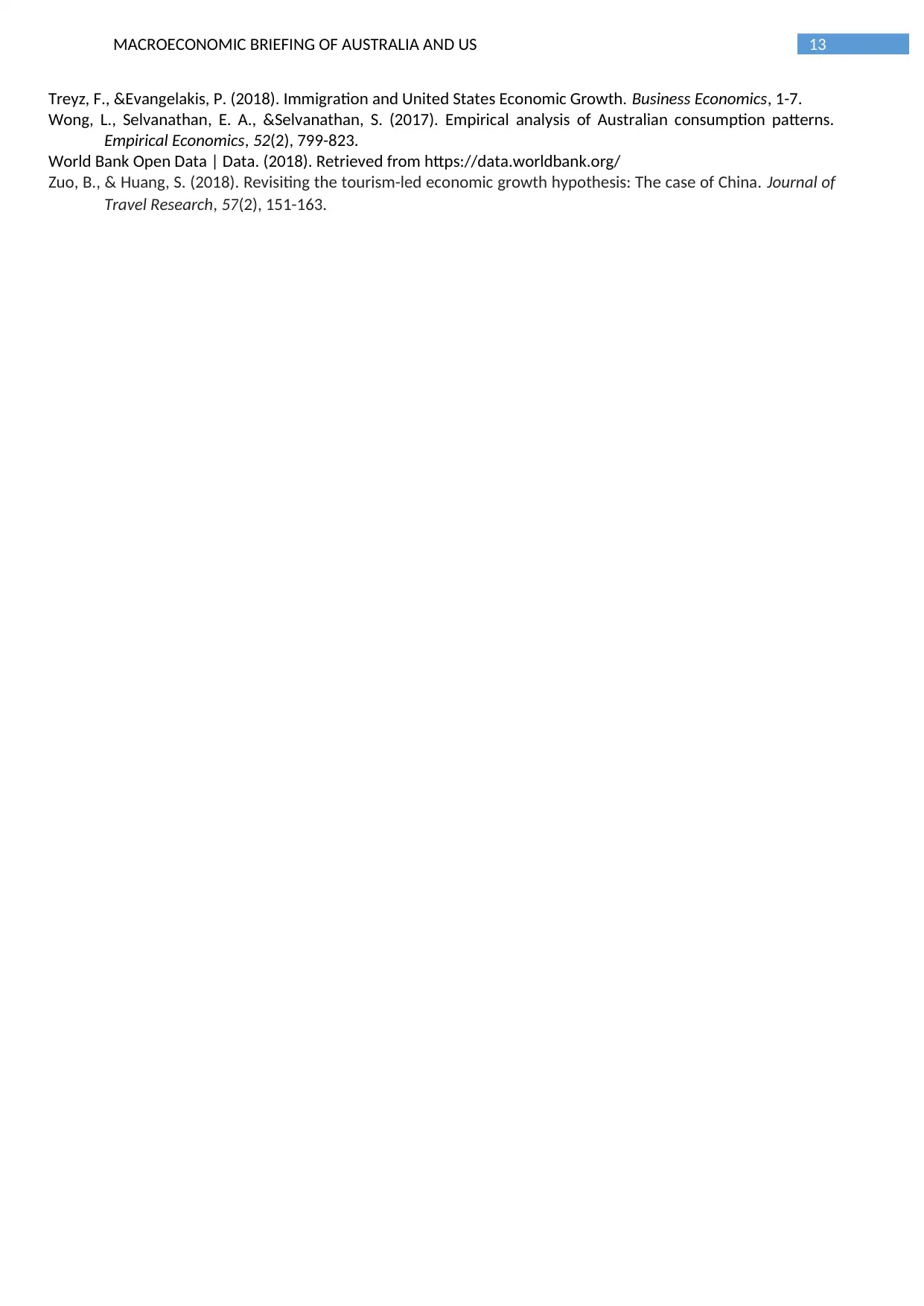
13MACROECONOMIC BRIEFING OF AUSTRALIA AND US
Treyz, F., &Evangelakis, P. (2018). Immigration and United States Economic Growth. Business Economics, 1-7.
Wong, L., Selvanathan, E. A., &Selvanathan, S. (2017). Empirical analysis of Australian consumption patterns.
Empirical Economics, 52(2), 799-823.
World Bank Open Data | Data. (2018). Retrieved from https://data.worldbank.org/
Zuo, B., & Huang, S. (2018). Revisiting the tourism-led economic growth hypothesis: The case of China. Journal of
Travel Research, 57(2), 151-163.
Treyz, F., &Evangelakis, P. (2018). Immigration and United States Economic Growth. Business Economics, 1-7.
Wong, L., Selvanathan, E. A., &Selvanathan, S. (2017). Empirical analysis of Australian consumption patterns.
Empirical Economics, 52(2), 799-823.
World Bank Open Data | Data. (2018). Retrieved from https://data.worldbank.org/
Zuo, B., & Huang, S. (2018). Revisiting the tourism-led economic growth hypothesis: The case of China. Journal of
Travel Research, 57(2), 151-163.
1 out of 14
Related Documents
Your All-in-One AI-Powered Toolkit for Academic Success.
+13062052269
info@desklib.com
Available 24*7 on WhatsApp / Email
![[object Object]](/_next/static/media/star-bottom.7253800d.svg)
Unlock your academic potential
© 2024 | Zucol Services PVT LTD | All rights reserved.




